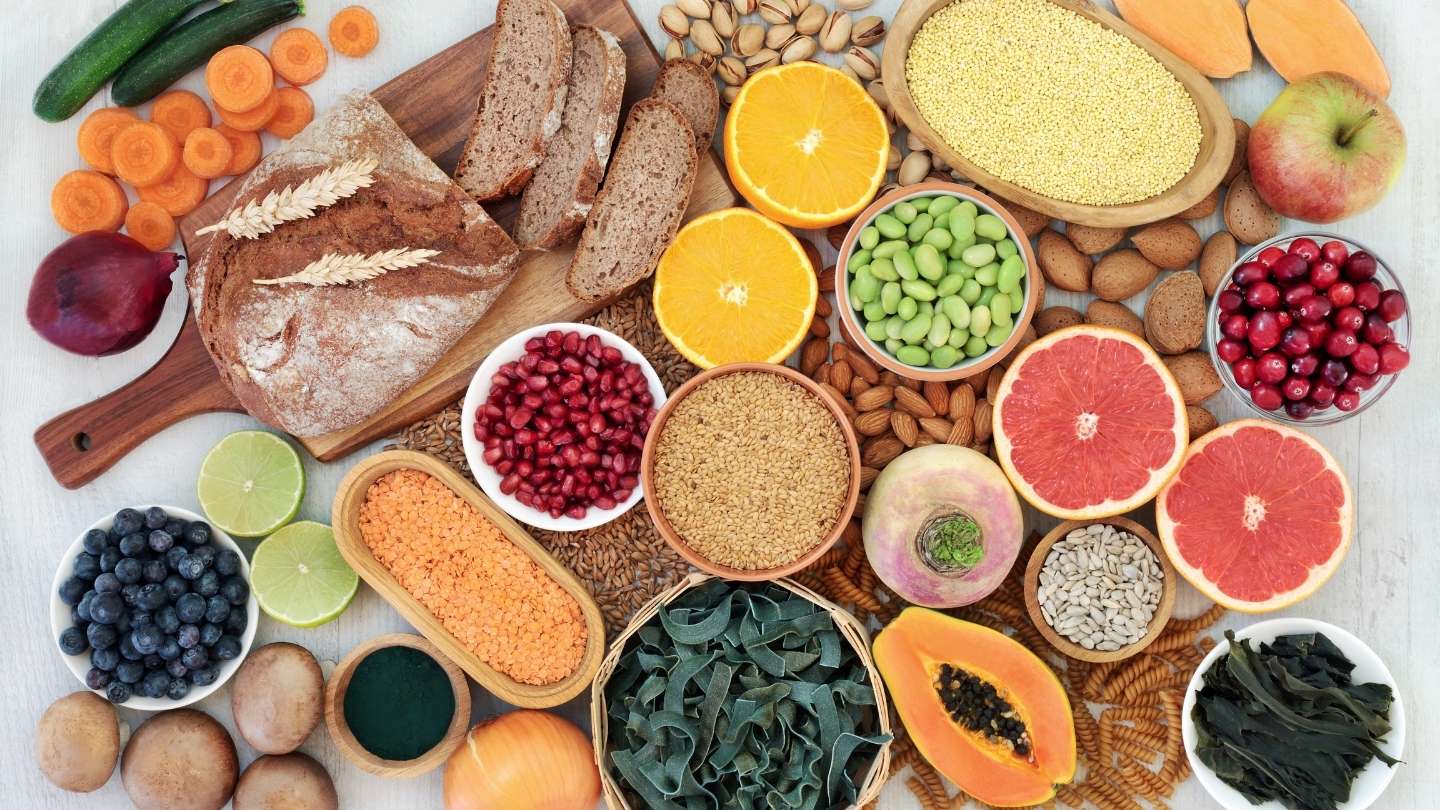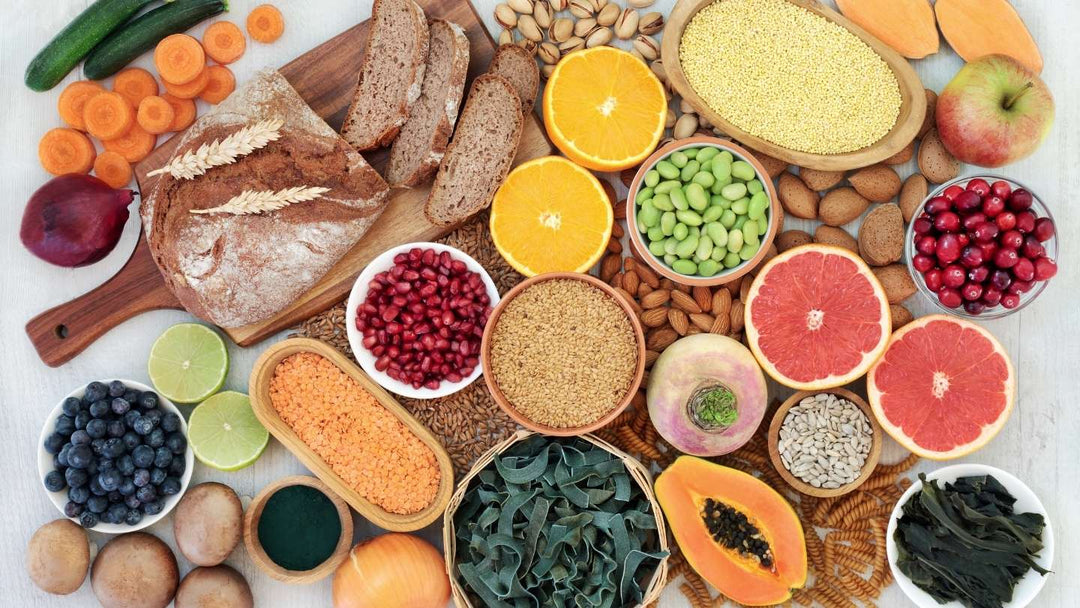Your Ultimate Guide to Fibre

A few years ago, my friend Lucy realised her energy levels were plummeting every afternoon. She’d grab a quick muffin or sugary snack to push through, only to crash again an hour later.
After chatting with her dietitian, Lucy tried a simple tweak: more fibre at breakfast—and a fibre-rich lunch. Within weeks, those midday crashes were gone.
Lucy’s experience is just one of many success stories highlighting how essential fibre is. But this isn’t just about feeling perkier; researchers worldwide have spent decades unravelling how fibre supports digestion, metabolic health, and even our immune system.
Ready to learn more? Read on for your ultimate guide to fibre-packed with science, tips, and a dash of real-life inspiration.
1. What Is Fibre, Really?
Short answer: Fibre is the part of plant foods (like fruits, vegetables, whole grains, legumes, nuts, seeds) that we cannot fully digest in our small intestine¹.
In other words, while proteins, fats, and most carbohydrates break down for energy, fibre moves along, often feeding beneficial gut bacteria² or adding bulk to help keep things moving. That’s exactly why Lucy’s high-fibre breakfast habit (she loved fruit smoothies) helped stabilise her energy levels- fibre slowed the absorption of sugars, kept her fuller, and avoided those rapid spikes and crashes.
Science Note: When scientists talk about fibre, they’re discussing compounds like cellulose, pectin, inulin, and resistant starch. Each type has unique effects, from lowering cholesterol³ to supporting the gut microbiome⁴.
2. Different Types of Fibre
2.1 Soluble Fibre
Ever noticed how oats get “gooey” when cooked? That’s soluble fibre forming a gel in water¹. This gel slows digestion, helps stabilise blood sugar, and can bind cholesterol, assisting with its removal⁵. If you’re an oat lover, you’re already boosting your soluble fibre intake.
2.2 Insoluble Fibre
Think of insoluble fibre as nature’s broom. It doesn’t dissolve in water, so it adds bulk to your stool, preventing constipation¹. You’ll find it in whole wheat, brown rice, and the fibrous skins of veggies.
2.3 Resistant Starch
This one's received superstar attention lately. Resistant starch “resists” digestion in the small intestine, heading to the colon, where friendly microbes ferment it⁶. That can produce short-chain fatty acids like butyrate, which may support colon health and aid in insulin sensitivity⁷. Cooked-and-cooled potatoes or rice, underripe bananas, and beans are classic sources.
2.4 Prebiotic Fibre
Not all fibre is automatically “prebiotic,” but certain types (like inulin) explicitly feed beneficial gut bacteria³. A thriving colony of these microbes can lower inflammation and help the gut barrier function at its best⁴.
Real-Life Take: Dave discovered resistant starch by accident—he meal-prepped rice, stored it overnight, and microwaved portions daily. “I had fewer sugar spikes, better energy,” he reported. It’s a small shift that can make a big difference.
Image: Psyllium husk- predominantly a soluble fibre
3. Why Fibre Is a Health Powerhouse
3.1 Metabolic Health and Diabetes
- Steadier Blood Sugar: Fibre slows carbohydrate absorption, preventing those rapid sugar highs and lows¹,⁸.
- Reduced Diabetes Risk: In large-scale studies, people eating more fibre show a lower chance of developing type 2 diabetes⁶. For Aussies—where over 1.3 million have diagnosed diabetes⁹—fibre is a free, simple tool in the prevention toolkit.
3.2 Happy Gut and Regular Digestion
- No More Constipation: Insoluble fibre keeps waste moving, preventing that uncomfortable backup¹.
- Gut Microbiome Love: Certain fibres feed your gut bacteria, producing short-chain fatty acids that may support colon cells².
- Anecdote: The next time you’re tempted to peel an apple, imagine the insides of your gut microbes waving a tiny sign that says, “Please, not the peel!”
3.3 Heart Health (Yes, Fibre Helps Your Heart)
- Lower Cholesterol: Soluble fibres like beta-glucan in oats can bind cholesterol-containing bile acids⁵.
- Cardiovascular Protection: Reviews find a 15–30% reduction in heart disease risk for those at the top end of fibre intake⁶. That’s a big claim for such a humble nutrient.
3.4 Weight Management and Satiety
- Fuller for Longer: Fibre-rich foods fill you up without stacking on kilojoules⁸. People on high-fibre diets often find it easier to maintain or lose weight¹².
- No More Energy Crashes: Stable blood sugar thanks to fibre means fewer “I’m starving!” moments that lead to overeating.
3.5 Beyond the Basics
- Colon Cancer Clues: High-fibre diets correlate with lower rates of colorectal cancer⁶,¹³, and resistant starch is under investigation for special cancer-protective properties⁷.
- Immune Support: By nurturing a diverse microbiome, fibre can help fine-tune immune responses⁴. Some early findings even suggest a role in reducing allergies or autoimmune issues.
Story: Pat (53 years old), overcame persistent constipation by simply adding a morning fruit smoothie with spinach and flaxseed. “I don’t think I’ve had a ‘backed-up’ day since,” Pat jokes. That’s the power of fibre—often immediate, tangible improvements in how you feel.
4. Fibre Through the Ages: A Quick History
From traditional diets rich in berries, nuts, and roots to modern industrialised fare, fibre intake has swung dramatically over time¹³.
- Traditional Societies: Indigenous Australian communities historically consumed far more fibrous vegetables and seeds¹⁰.
- Refined Foods & The Drop: Industrial milling left us with white bread, white pasta-stripped of bran and germ¹.
- The Fibre Hypothesis: In the 1970s, Dr Denis Burkitt famously linked low-fibre Western diets with diseases like colon cancer¹³. Research blossomed, and now global health guidelines emphasise wholegrain breads, cereals, fruits, vegetables—all fibre powerhouses¹⁰.
Modern Realisation: We need to reclaim some of that high-fibre approach. As Dr Burkitt put it, “What happens in Western nations is not normal.” He was talking about the rise in chronic diseases and how people in rural Africa rarely encountered them, largely due to a high-fibre diet.
Image: A food production facility in the US.
5. Simple Ways to Boost Your Fibre Intake
1. Wholegrain Swaps
-
- Switch from white bread to wholemeal, white rice to brown, refined cereals to oat-based ones.
- Look for at least 3 g of fibre per serve on food labels.
2. Legumes, Legumes, Legumes
-
- Add chickpeas to salads, lentils to soups, or try black beans in a veggie burger. Legumes are “fibre bombs”—cheap, versatile, and protein-packed.
3. Fruits and Veggies with Edible Skins
-
- Keep the peel on apples, pears, potatoes (where practical). The skin often holds extra insoluble fibre.
- Aim for Australia’s recommended 2 serves of fruit and 5 serves of vegetables daily¹⁰.
4. Nuts, Seeds, and Flax
-
- Sprinkle chia or flaxseed on yoghurt, salads, or cereal. Nuts and seeds also provide good fats and a bit of protein.
5. Cook and Cool Your Starches
-
- For a resistant starch boost, cook your potatoes, rice, or pasta and then let them cool. Use them in salads or reheat them later. You’ll up the resistant starch content, feeding beneficial gut microbes⁶.
5. Struggling to get enough fibre? Supplement.
-
- If you’re falling short on daily fibre despite eating more whole grains, fruits, vegetables, legumes, nuts, and seeds, consider a fibre containing supplement (e.g., check ingredients for psyllium husk, inulin, or wheat dextrin) to top up your intake.
Pro tip: Introduce supplements slowly and drink extra water to minimise gas or bloating. Whole foods should remain your main fibre source, but supplements can be a convenient back-up when life gets busy.

Image: Refined vs wholemeal carbohydrates: Brown rice still has its bran and germ layers intact—retaining extra fibre, vitamins, and minerals—while white rice is milled to remove these nutrient‐rich parts.
6. What Happens If You Don’t Get Enough Fibre
- Constipation: Hard stools, less frequent bowel movements, and related discomfort¹,⁸.
- Blood Sugar Rollercoaster: Low-fibre, high-GI foods cause spikes and crashes, elevating type 2 diabetes risk⁶.
- Higher Cholesterol: Without enough fibre to bind bile acids, “bad” LDL cholesterol may stay elevated⁵.
- Weight Gain: Less satiety often leads to more kilojoules. Over time, that means extra weight, plus increased risk of heart disease and diabetes¹².
- Colon and Digestive Problems: Low-fibre populations tend to see more diverticulosis and, in some studies, higher rates of colon cancer¹³.
7. Exciting New Directions in Fibre Research
-
Gut Microbiome Personalisation
- Scientists are investigating how certain fibres selectively feed different gut microbes. One day, you might get a personal “fibre prescription” based on your gut profile²,⁴
- Resistant Starch vs. Cancer
-
- Trials like CAPP2 suggest resistant starch could help lower cancer risk in high-risk groups⁷,¹³. More data is coming, but it’s promising.
- Gut-Brain Axis
-
- We already know the gut and brain talk to each other. Now, there’s speculation that prebiotic fibres may support mental health. Though it’s early research, it indicates that nutrition might shape mood and stress response⁴.
-
Immune Regulation
- Some experts think modern diets (low in fibre) fuel rising allergies and autoimmunity. Fibre’s fermentation products might help “train” the immune system to stay balanced¹².
8. Conclusion: Fibre Is Your Underrated Hero
From Lucy’s midday energy crashes to Dave’s discovery of resistant starch, you’ve seen how small changes around fibre can make everyday life better. On a bigger scale, reintroducing high fibre produce into our diets can potentially slash the risk of serious diseases—heart issues, type 2 diabetes, even some cancers¹,⁵,⁶.
Why wait? If you’re monitoring carbs to manage diabetes, think of fibre as a built-in “shock absorber” for your meals—it slows digestion, moderates blood sugar spikes, and helps you feel more balanced throughout the day.
Even simple changes—like including a fibre-containing supplement or meal replacement into your morning routine or swapping white rice for brown at dinner-can help keep glucose levels steadier. Fibre is more than roughage; it’s your ally for blood sugar control and overall health. Embrace it, and both your body and your lab results may thank you.
(Disclaimer: This blog is for educational purposes. Always seek personalised advice from a dietitian or health professional.)
References
- Dahl WJ & Stewart ML. (2015). Position of the Academy of Nutrition and Dietetics: Health Implications of Dietary Fiber. Journal of the Academy of Nutrition and Dietetics, 115(11):1861-1870.
- Turnbull ND et al. (2021). Definition and Dietary Sources of Dietary Fiber. Advances in Nutrition, 12(5):129-137.
- Vinelli V et al. (2022). Prebiotic Fibers and SCFA Production. Nutrients, 14(13):2559.
- Venter C et al. (2022). EAACI position paper on dietary fiber and immune health. Allergy, 77(11):3185-3198.
- Heart Foundation Australia. (2019). Dietary Recommendations for Heart Health.
- Mathers JC et al. (2022). Long-term effect of resistant starch on cancer risk in lynch syndrome (CAPP2 trial). The Lancet, 400(10353):79-80.
- Reynolds A et al. (2019). Carbohydrate quality and human health: a series of systematic reviews and meta-analyses. The Lancet, 393(10170):434-445.
- Clark MJ & Slavin JL. (2013). The effect of fiber on satiety and food intake: a systematic review. Journal of the Academy of Nutrition and Dietetics, 113(10):1494-1499.
- Australian Bureau of Statistics. (2018). National Health Survey: First Results.
- National Health and Medical Research Council. (2013). Australian Dietary Guidelines.
- Slavin JL. (2005). Dietary fiber and body weight. Nutrition, 21(3):411-418.
- Burkitt DP. (1971). Related disease—related cause? The Lancet, 297(7695):1229-1231.
- Australian Institute of Health and Welfare. (2020). Burden of gastrointestinal conditions in Australia.
Author’s Note: If you find this guide helpful, share it with a friend—who knows, their next meal choice might just shift from “white roll” to “wholegrain” and spark a whole new level of wellbeing. Thanks!






